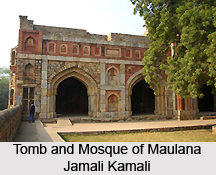 Tomb and Mosque of Maulana Jamali Kamali is located in the Archeological Village complex in Mehrauli of Delhi. It includes two monuments that are positioned adjacent to each other. One is the mosque and the other is the tomb of two persons namely Jamali and Kamali.
Tomb and Mosque of Maulana Jamali Kamali is located in the Archeological Village complex in Mehrauli of Delhi. It includes two monuments that are positioned adjacent to each other. One is the mosque and the other is the tomb of two persons namely Jamali and Kamali.
History of Tomb and Mosque of Maulana Jamali Kamali
The mosque and the tomb were built in 1528-1529 in the honour of Jamali and Kamali. Jamali also known as Shaikh Jamali Kamboh or Jalal Khan was a well-known Sufi saint who lived during the pre-Mughal dynasty rule of the Lodi`s. It was a period from the rule of Sikander Lodi to the Mughal Dynasty rule of Babur and Humayun. Unlike Jamali, the history of Kamali is not known clearly but according to historians he was associated with Jamali. They were buried adjacent to each other hence their names are tagged together as "Jamali Kamali". It is assumed that the reason for the Kamali name could possibly be that it rhymes with Jamali.
Architecture of Tomb and Mosque of Maulana Jamali Kamali
The Jamali Kamali mosque is constructed in an enclosed garden area with southern entry. Materials like red sandstone and marble have been used to design the structure. The building comprises of prayer hall, a large courtyard, and five arches. The arches are embellished with beautiful ornamentation. Few Koranic inscriptions have been used to adorn the niches and walls. The rear end of the mosque is designed with oriel windows. It also has a small window on the central arch.
The tomb of Jamali-Kamali is located adjacent to the mosque on its northern side. It has square structure and flat roof. It is painted in red and blue colour. The walls of the tomb are decorated with inlaid coloured tiles inscribed with Jamali`s poems. Like the mosque, it too exhibits Koranic inscriptions. It is said that the decorations in the tomb gives the impression of "stepping into a jewel box".
Conservation of Tomb and Mosque of Maulana Jamali Kamali
Archaeological Survey of India or ASI has undertaken the responsibility of conserving the monument. Tomb and Mosque of Maulana Jamali Kamali is one of the 172 monuments which falls under the jurisdiction of the Delhi Archaeological circle, of ASI, identified for restoration.
Connectivity of Tomb and Mosque of Maulana Jamali Kamali
It can be well assessed via roadway, airway and railway. Delhi has well maintained transport system. The closest airport is Indira Gandhi International Airport and the nearest railway station is Nizamuddin Railway Station.



















